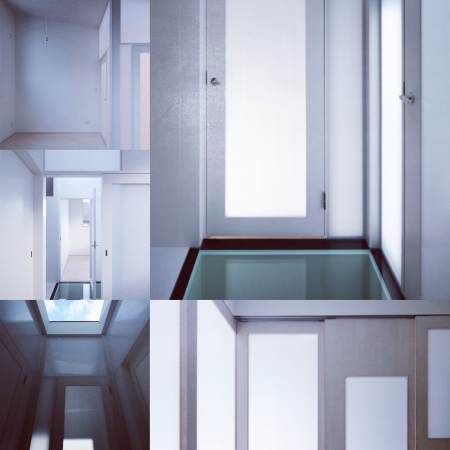面で呼応し合う
デザインが幾重にも折り重なる姿はあまり見たことが無いので、なかなかイメージができないが、コラージュの技法を使った絵画を思い浮かべて、その一つ一つがデザインされたものだとしたらイメージがしやすい。
ピュリスムの絵画も、例えばコルビジェの絵画も、モチーフの重なり具合で画面を構成し、そのモチーフの重なりの輪郭線だけを抜き出して、そのモチーフ自体もそもそも平面化されており、輪郭線だけがまた別のモチーフになっていたり、別の意味をつくり出していたりするので、このモチーフもデザインされたものだとしたら、またコラージュとは違った折り重なり具合をイメージできる。
コラージュもピュリスムも平面化された画面構成をしており、それは簡単に言うと、陰影がはっきりとした立体感を出す絵画に対する新しい試みだった。モチーフに陰影をつけて奥行き感を出すのでは無くて、モチーフ自体を幾重にも折り重ねてモチーフの存在に意味合いという奥行きを付けていった。
コルビュジエは、ピュリスムの表現技法を建築に用いて、内部空間を構成していた。午前はアトリエで絵を描き、午後は事務所で建築の設計をしていたというコルビュジエ にとって、午前のピュリスムの絵を描く時間は建築の実験をしていたのだろう。
重なりの輪郭だけが浮き出たような内部空間を有するコルビュジエ設計のパリのラ・ロッシュ=ジャンヌレ邸は、その内部空間に身を置くと、その輪郭に沿うようなアクティビティが自然に起こるような感じがした。それは、その輪郭と人の関係性が密接だからであろう。
ただ、そのラ・ロッシュ=ジャンヌレ邸を体験しているからこそ、きっと実現したい内部空間は輪郭という線では無くて、壁という面を用いて、もっと建築と人が呼応し合うものにならないかと考えてしまう。
"Resonate with each other"
I haven't seen any of the designs that fold over and over, so I can't easily imagine the image. However, if I think of paintings that use collage techniques, and if each of them is designed, it's easy to imagine.
Both the paintings of Purism and, for example, the paintings of Corbigier, compose the screen based on the degree of overlap of the motifs, extract only the outline of the overlap of the motif, and the motif itself is originally flattened, and only the outline is another Motifs or create different meanings, so if this motif is also designed, you can imagine how it folds differently from a collage.
Both the collage and the purism have a flattened screen composition, which, in short, was a new attempt at painting with clear shadows and a three-dimensional effect. Instead of shading the motif to give it a sense of depth, the motif itself was folded over and over to add depth to the existence of the motif.
Corbusier used purism expression techniques in architecture to compose the interior space. For Corbusier, who painted in the atelier in the morning and architectural design in the office in the afternoon, the time of painting the Purism in the morning would have been an architectural experiment.
La Corcheier-designed La Roche Jeannelet's house in Paris, which has an interior space where only the outline of the overlap emerges, when you put yourself in that interior space, it seems that activities along the outline occur naturally. did. The reason is that the relationship between the contour and the person is close.
However, just because I experienced La Roche-Jeanneret's house, I wondered if the interior space I wanted to realize would not be a line of contour, but a wall that would make architecture and people interact more Would.

